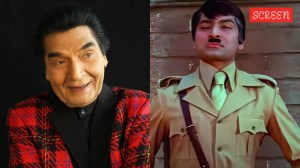A city changes its colours
Once there was a Kolkata that was awash in redthe red of party flags of the Left Front that ruled the state for a record 33 years. But as Mamata Banerjee sees her best chance of coming to power,Kolkatas colours are changingfrom red to the green-and-orange of the Trinamool Congress by Subrata Nagchoudhury Photographs: Subham Dutta
In Kolkatas central business district of BBD Bag,a UNESCO-listed heritage zone known for its elegant British-era architecture,stands New Koilaghat building. It is a landmark address,a massive 14-storeyed structure that overlooks Strand Road and the Hooghly. The building houses offices of the Eastern and South Eastern Railways,including one of the biggest railway reservation booking centres in the country. These days,New Koilaghat is getting a fresh coat of painta sparkling orange and verdant green combinationat an estimated cost of Rs 30 lakh. Its a palette thats hard to miss in a state where the monochrome red colour has dominated lifein politics and outside.
Green and orange are colours of the Trinamool Congress and its chief,Mamata Banerjee,who,by all accounts,is set to dislodge the Left Front government in the West Bengal assembly elections of 2011. In the process,Kolkata,the Left governments seat of power from where it ruled the state for a record 33 years,is getting a fresh coat of paint. Green,it seems,is slowly becoming the new red here.
Artists,painters,festoon-banner writers and graffiti artists,who have all these years dabbled in red,are now wielding paint brushes that more often than not are dipped in Trinamool colours. This new visual reality is evident in the cityscape: road dividers,factory gates,auto stands,taxi parking lots,public venues and street crossings are increasingly being painted green and orange.
Not surprisingly,the Left is seeing red over the Trinamools colour invasion. Md Salim,former CPM MP and now a Central Committee member,says,The Trinamool Congress is blatantly loud about declaring its presence. A change of guard has little to do with changing colours of buildings and painting the city green and yellow.
He also hits out at the massive green,yellow and white cut-outs of the Opposition leader (Mamata Banerjee) at street crossings and public places. These factory made cut-outs in Kolkata are a distortion of the citys political culture and trends. Even leaders like Bidhan Chandra Roy,the first Congress chief minister of Bengal,didnt have such huge cut-outs. It reflects the inner hallmarks of an anti-Left leader whose individual whims get precedence over everything else. True change should reflect in policies,in ideology,in socio-economic conditions and not in painting buildings or putting up party flags. We too decorate venues of conferences and public meetings with our flags,but remove them as soon as the programme is over.
The colour red has always been a dominant theme in Kolkatathe festive red of the pujas,the heritage red of some of the iconic buildings in the city,such as Writers Building and the General Post Office,and of course,the official red of the Left parties. But with Banerjee and her Trinamool Congress on a roll,the colour has somewhat lost its sheen.
The autorickshaw stand at the EM Bypass-Beliaghat junction tells the story of this transformation. A portrait of Subash Chakraborty,the late CPM leader,and a couple of red CITU flags are outnumbered by the green and yellow flags of the Trinamool. Ganesh Dey,one of the unit members of the newly formed All India Trimanool Trade Union Congress (AITTUC),claims that of the 100 autorickshaws plying on this route,82 are its members. The 12 that are with the CITU will soon change sides,he says.
The changing colours of the city are rooted in its political numbers. Only 33 of Kolkata municipalitys 141 wards are now under the Left. Purnendu Bose,the West Bengal president of the All India Trinamool Trade Union Congress,says that in the last one year,there has been a phenomenal growth in the number of registered trade unions of the partyfrom 450 units in 2009 to over 700 now.
The Left may be down now,but there was a time when the ruling front too tried a similar brush stroke on the city. In 1978,a year after the Left came to power in 1977,the states Public Works Department painted the dome atop Sahid Minar,a memorial for a British army officer,at Esplanade a striking red. The colour riot came in for severe criticism from various quarters,with film director Satyajit Ray calling it vulgar. Finally,Jyoti Basu had to intervene and restore the red tomb to its original colour.
Now,three decades later,the city is getting a new shade. With Banerjee also the railway minister,railway properties were the first to change colours. A senior railway official says the transition plan became evident when the ministry ordered for old railway station buildings to be repainted in shades of green,yellow and white. The cream-and-terracotta Sealdah station complex too changed colours and is now a massive expanse of green and orange.
Listed heritage buildings like Old Koilaghat and the Fairlie Place Eastern Railway headquarters thats on the right flank of Writers Building,have been spared of the colour onslaught so far. But a survey of the inner corridors of Fairlie Place reveal that change is catching up: the railings of the grand old staircase inside are in green and yellow.
A senior railway official at the helm of this silent colour revolution says that the Railways has always had a tradition of red,a practice that dates back to the days of the British Raj. In those days,he says,red brick structures denoted power and authority and were usually administrative centres. And so it was with railway buildings.
An eastern railway engineer,who too didnt want to be quoted,says red had its own utility value: bricks structures with a coat of red paint,he says,are resistant to wear and tear more than any other shade.
But for Banerjee and her party,the change to green has its own utility value. Sudip Bandyopadhyay,Trinamool Congress MP from Central Kolkata,says,The younger generation has lost their confidence in redbe it the symbolic flags or the ideology. They are backing the Trinamool Congress and they are the ones who are painting the city green. It is difficult to control such a huge upsurge in favour of the Trinamool. Red has come to represent the tormented past and green is the colour of the future.
TMC partymen as well rail officials recall that in some of the early public functions after Banerjee took over as railway minister,the sight of red in any décor would have her fuming. Didi would start throwing tantrums. We sensed her dislike for red and immediately decided to ensure that the colour was eliminated from railway functionson carpets,chairs,cut-outs,placards and so on. In close circles,we call it red-phobia. Some of the officers joke that the day is not far when we will be asked to remove red signals from railway tracks, says a railway official.
One of the managers of Modern Decorators,a firm that manages mega-Mamata shows in the city,admits he had to remove his old stock and make fresh investments on green chairs,green carpets,green cushion covers,green screens etc.
Banerjee even got superfast trains,like the Duronto,to change colours. In September 2009,she flagged off the Sealdah-New Delhi Duronto Express that had a splash of,what else,green and orange. She engaged Shuvaprasanna,once a Left-leaning artist who is now in the Trinamool camp,to design a new colour scheme for Durontos connecting Kolkata to Delhi and Mumbai.
Green is a unique colour, says Shuvaprasanna. I visualised and suggested a splash of green and orange on Duronto coaches and the effect came out brilliantly. Does he see his work as having contributed to the citys visual transformation? It is inevitable. Under the Left,we had almost forgotten the existence of the tricolour in Bengal. Some of the most memorable dates in our calendarIndependence Day,Netajis birthday,Republic Daywere all painted in red. Red is being wiped out of the entire world,let alone West Bengal. In Bengal,the colour red has acquired a grisly connotation and stands for the blood let loose by the Communists. The colours of the tricolour are making a refreshing comeback, says Shuvaprasanna.
But Wasim Kapoor,another well-known painter and artist,believes changing colours of a city to match a political belief is reflective of a distorted mindset. The day is not far off when one would have Writers Building or the Raj Bhavan painted in political shades. I am vehemently against this,be it red or green. As an artist,I can say with all certainty that such attempts are neither artistic nor aesthetic.
But in Kolkata,even colours cant claim to be apolitical. For the first time in the history of Bengal politics,Labour Day (May 1) this year saw a splash of Trinamool colours and the tricolour as over 20,000 workers of Banerjees party hit the streets. The writing is on the wallin shades of green.





- 01
- 02
- 03
- 04
- 05

























